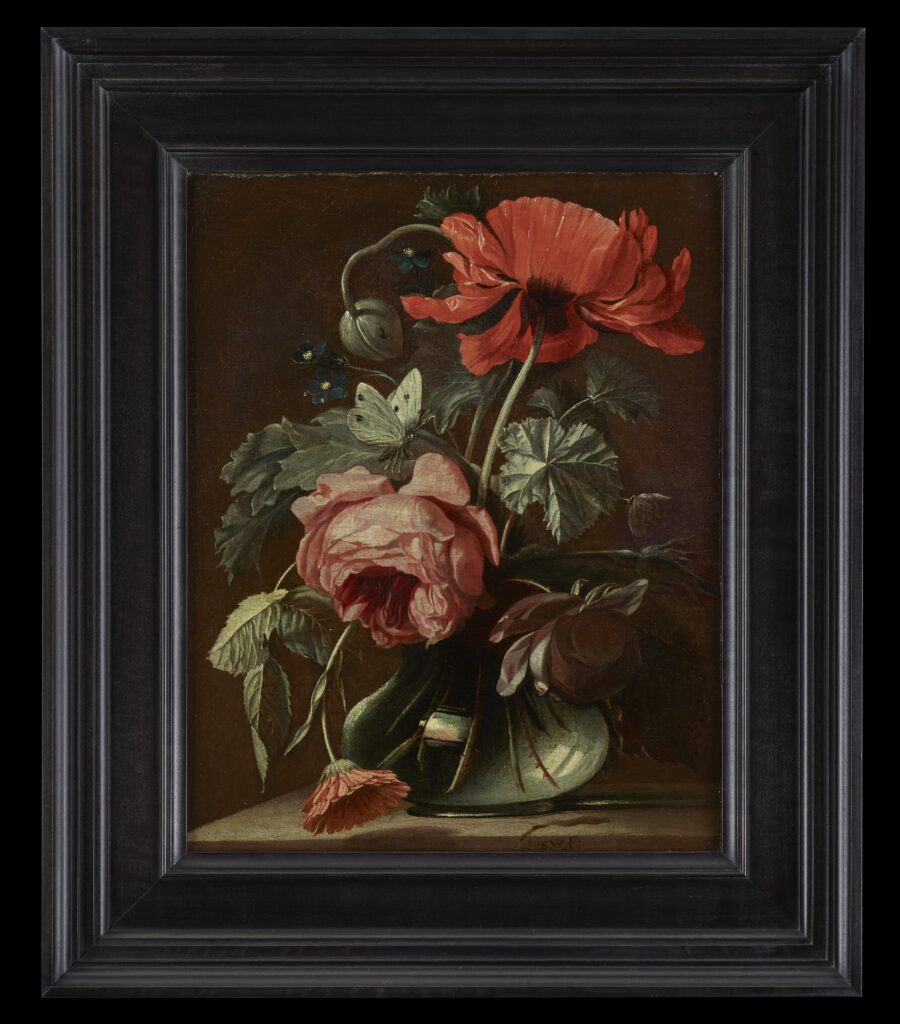Simon Pietersz Verelst
1644 - 1721
A Still Life of a Poppy, pink Roses, Marigold, and Forget-me-not in a Glass Vase on a Table

Medium:
Oil on Canvas
Category:
Dimensions:
30(h) x 23.5(w) cms
Framed Dimensions:
39.5(h) x 33.5(w) cms
Essay:
Simon Verelst was by far the most accomplished of the Verelst family of painters. He was born in The Hague, became a pupil of his father, the genre and portrait painter Pieter Verelst, and was probably elected a member of his local guild before moving to England in 1668. Samuel Pepys famously met him in April 1669 in his studio:
"A Dutchman newly come over, one Everelst...did show us a little flower-pott of his doing, the finest thing that ever I think I saw in my life -- the drops of Dew hanging on the leaves, so as I was forced again and again to put my finger to it to feel whether my eyes were deceived or no. He doth ask £70 for it; I had the vanity to bid him £20 --but a better picture I never saw in my whole life, and it is worth going twenty miles to see."
The French influence in Verelst's still lives insured that his work was well received by the court of Charles II and he was greatly assisted by the patronage of the King's mistress, Louise de Keroualle, Duchess of Portsmouth and also by the second Duke of Buckingham. He is thought to have visited Paris briefly in 1680. Amongst his pupils were Maria Verelst (the daughter of Herman Verelst) and Louis Michiel.
Verelst's style is individual; his long sojourn in his adopted London meant that he was out of the mainstream of European still life painting. His dramatic still lifes with asymmetrical or diagonal compositions are comparable to the work of Abraham Mignon and Rachel Ruysch. The chiaroscuro effect of lighting a painting's focal point and setting it against a warm, dark background is also typical of his work.
-
This work is a fine display of Verelst's talents as a flower painter. Worked on a small scale the composition is kept carefully simple so as not to overwhelm with a small selection of flowers in a wide-bottomed glass vase. An S-shaped axis can be discerned running through the picture, which helps to unify the whole composition with a pleasing sinuousness.
The erudite three-dimensionality is where Verelst's powers shine. This can be seen most clearly in the shading of the rose leaves where raking light shows the angular veins and membrane. The budding poppy is another pleasing passage where the wavering stem of the flower spirals around on itself, revealed with small touches of highlight and shading. This hanging bud is a hallmark of Verelst and can be seen in many other paintings by him.
A work by Verelst of a similar composition and scale (though with a flaming tulip rather than a poppy) is in the Museum Bredius, The Hague (inv. no. 124-1946) and is dated 1669, the year after Verelst moved to London. Another similar small-scale work in The Cleveland Museum of Art, Ohio (inv. no. 1982.246) is also dated c.1669. We might therefore date our own picture to the same period.
The pale butterfly landing on the rose is a female Pieris rapae or Small White butterfly, also known as a Cabbage White.
Provenance:
With Eugene Slatter, London, circa 1945 (according to a mount at the RKD, The Hague).
Private collection, London.